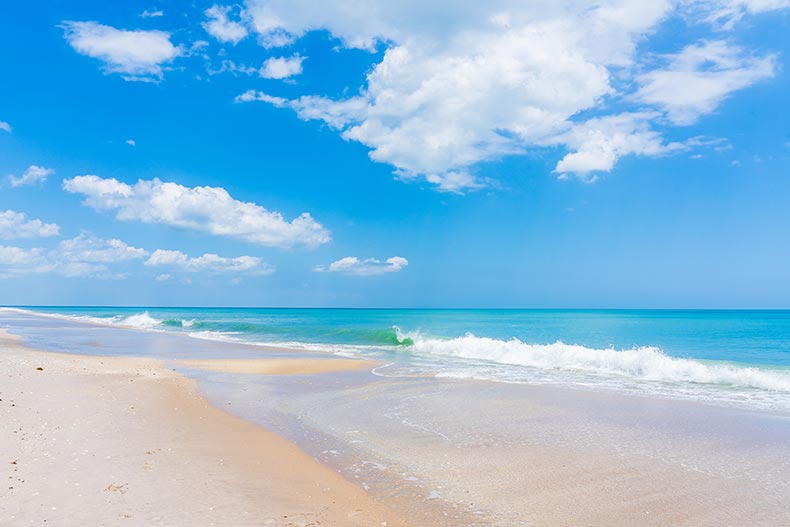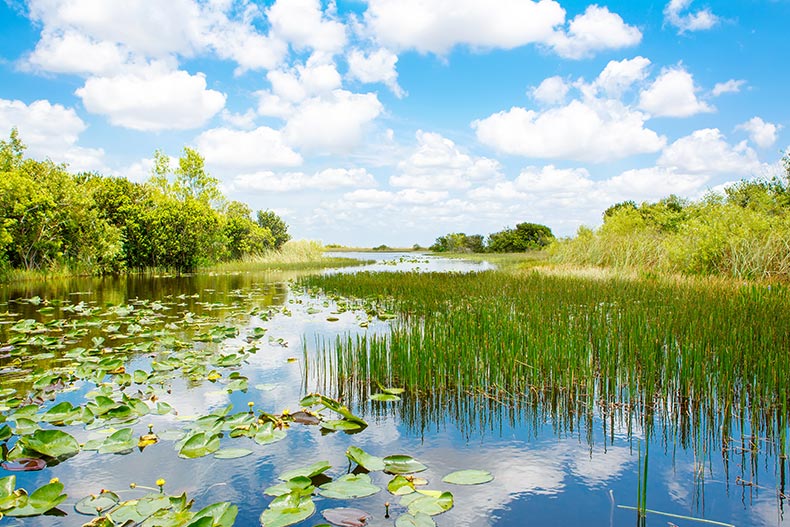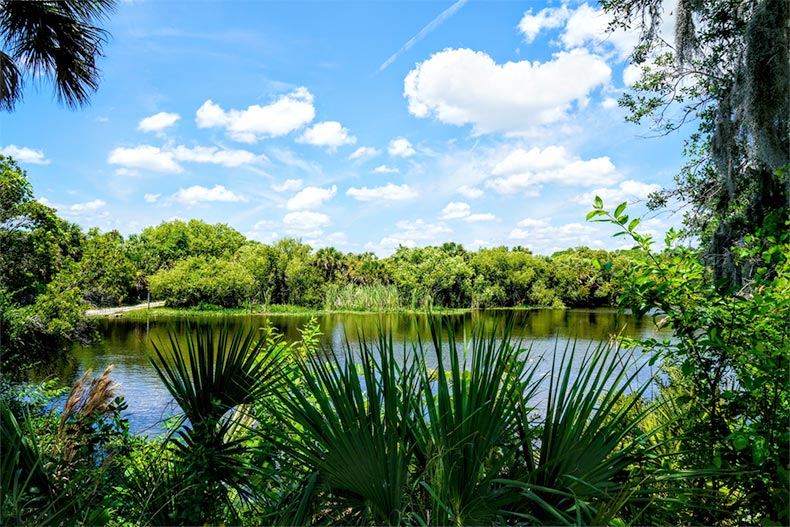It surprises no one that Florida remains one of the most popular retirement destinations in the U.S. Retirees make up more than 28% of Florida residents, and over 6 million residents in the Sunshine State are aged 60 and older.
So why is living in Florida a retirement dream? The weather is warm, there’s no state income tax, and Florida offers a lifestyle that caters to active adults interested in recreation, entertainment, dining, and travel. If moving to Florida is part of your retirement plans, we’re letting you know what it’s like and what you can expect when you get here.
Living in Florida: Climate and Lifestyle

The National Institutes of Health conducted a study linking sunshine to mental health, but sunny days are good for physical health too! Luckily, Florida provides residents with an average of 230 to 255 vitamin D-filled days every year.
Residents can generally expect mild winters and hot, humid summers. However, it’s a big state, and northern Florida has colder winters than Miami. Also, inland communities won’t get the sea breezes found on the Atlantic and Gulf coasts. The rainy season arrives in the late spring and continues throughout the summer. In Florida, late afternoon thunderstorms are as predictable as migrating winter birds.
Having a temperate climate all year long means outdoor recreation can happen in January as easily as it can happen in June. Tee times can be made throughout the year. Lunch can be served on outdoor patios. Beaches remain busy with swimmers, surfers, and sunbathers. There’s also fishing, boating, tennis, pickleball, hiking, and camping. All of it remains available to residents no matter what the season.
Cost of Living in Florida and Where to Live

For a long time, the cost of living in Florida was dramatically low, but with more people moving into the state, costs have come up a bit. According to Best Places, the total cost of housing, food, transportation, health care, taxes, and other necessities is 3.1% higher in Florida than the U.S. average. However, it’s still much cheaper to live in Florida than in many other northern states.
Taxes in Florida
Living in Florida is an excellent idea for retirees who want to keep more of their income. There’s no state income tax, so Social Security income and other types of retirement income are only subject to federal taxes. There’s also no estate tax or inheritance tax. Property and sales taxes will depend on local governments, but they’re generally pretty easy for residents to absorb, especially without the income tax burden or the tax on retirement benefits.
Real Estate
Home values and prices have risen in the last few years, but buyers can still get a lot more for their money in many Florida markets than in other places across the U.S.
There’s a diversity of housing options when it comes to relocating to Florida for retirement. Coastal communities have always been popular, but in recent years, Central Florida has also been a desirable location. It offers rolling horse farms, thriving cities like Orlando, and a lower cost of living than some of the coastal cities. Also, condos are affordable in cities like Tampa, Jacksonville, Ocala, and West Palm Beach.
Many people who retire to Florida choose a home in a 55+ community. They’re available in every budgetary bracket, from affordable attached villas to large estates with swimming pools and three-car garages. These communities also have many resort-style amenities, which keep residents active and social. Also, social calendars are full of book clubs, wine tastings, field trips, and parties.
Florida Health Care and Medical Services

Florida’s health care networks are well-known. People come to Moffitt Cancer Center in Tampa for world-class cancer treatment and cutting-edge clinical trials. Also, Mayo Clinic in Jacksonville is a leading medical institution for research, neuroscience, transplants, and cancer treatments.
When moving to Florida, retirees need to be close to the specific medical services they need. Most of the health care providers in Florida understand that a large percentage of their patients will be covered by Medicare, and it’s easy to find in-network providers in nearly every part of the state. Large teaching hospitals such as the University of South Florida in Tampa, the University of Florida in Gainesville, and the Miller School of Medicine at the University of Miami offer long lists of treatment specialties, geriatric services, primary care providers, and specialty programs around aging, mental health, and chronic illness.
What to Do When Living in Florida: Activities

Ensuring that housing, taxes, and health care are all taken care of is an important part of planning a retirement. But there’s also the fun! Some of the most popular recreation and entertainment activities in Florida include:
- Travel – Getting around Florida is fairly easy, thanks to the Florida Turnpike and well-traveled interstates like I-4, I-75, I-10, and I-95. Cruise ships leave from Miami, Fort Lauderdale, Tampa, Cape Canaveral, and Jacksonville.
- Shopping – All around Florida, residents enjoy malls, local boutiques, outlet centers, and regional artists showcasing at festivals, fairs, and farmers markets.
- Arts and Culture – Museums are abundant. There’s the Appleton in Ocala, the Institute of Contemporary Art in Miami, the Lightner Museum in St. Augustine, or the Ringling Museum in Sarasota. From local shows to permanent collections, there’s always something to look at. Performing arts are just as popular, with major acts playing multiple Florida cities all year.
- Outdoor Recreation – From golf (more than 1,250 courses in the state) to fishing and boating to hiking and wildlife watching, it’s easy to spend time in nature when living in Florida. Launch a kayak in the Suwannee River or charter a sailboat somewhere off the Treasure Coast. Not only are there sandy beaches, but also freshwater lakes and many natural springs.
- Sports – Professional baseball, hockey, basketball, and football can be found in cities across the state. And spring training baseball makes the sport even more accessible to fans. There’s also soccer and tennis and competitive swimming. Residents cheer on a favorite team or play recreationally themselves.
Daily Life in Florida as a Retiree

What does an average day look like when living in Florida? Depends on what you like to spend your time doing.
Many active adults are likely to start the day with a coffee on the balcony or patio of their home in a 55+ community. They might walk the dog or join a friend for a fitness class. There might also be a lunch date. Florida is known for its fresh seafood, its farm-to-table restaurants, and its quirky cafes where it’s easy to grab a sandwich and an iced tea. The day might include a bit of shopping or a cooking class in a community’s demonstration kitchen. Maybe there’s a shuttle running to the beach for a sunset walk or a happy hour to attend in the clubhouse.
Daily life is also seasonal in Florida. Most cities and communities see their populations swell during the snowbird season when part-time residents come south to their warmer homes. Snowbirds tend to arrive in October or November and stay through March or April. A lot of 55+ communities will have extra activities planned for those months when more residents are looking for entertainment.
Challenges to Retiring in Florida

There are challenges to living in Florida, and the biggest challenge is hurricanes. The season starts on July 1 and runs through November 30. The threat of serious tropical weather includes high winds, torrential rains, and potential flooding. Even inland communities are at risk as these storms seem to get stronger and less predictable every year.
Preparation is a Florida resident’s best friend when it comes to storms. Look for a home that has hurricane shutters or protective windows. Also, make sure you have adequate insurance. Pay attention to weather reports and heed evacuation warnings. An emergency plan will protect your property and your peace of mind.
Another challenge is crowds. Tourism is a huge industry in Florida. Expect to fight for a spot at your favorite restaurant, especially if you’re living in a city that sees a lot of vacationers. Daytona Beach during Spring Break, for example, can feel overrun.
it’s always important to remember that Florida has its own vibe. Some people retire here and fit right in. Others find it takes a bit longer to adjust to the flat landscape, the long, hot summers, and the continued development in the state’s most popular areas. Locals can be pretty protective of what they consider “old Florida,” before it became a retirement destination. They’re still welcoming, though, and always happy to share stories with new residents.
55places.com Can Help You Move to Florida
Living in Florida is a marvelous way to spend your retirement. There’s the warm weather, the bountiful activities, the glorious beaches, and lots of history, art, and culture. There are also 55+ communities across the state that make every day feel like a vacation. All of this makes the occasional stormy weather and the humidity worth it.
Ready to seriously consider making the move? Browse available homes in Florida’s top 55+ communities, or connect with 55places.com today for personalized guidance.










